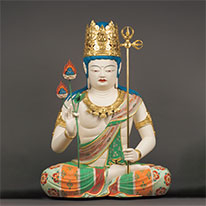General Information
To prevent the spread of the coronavirus, "Timed Entry Tickets" for this exhibition must now be reserved online.
Exhibition dates are subject to change and visitors numbers may be limited. Updates will be posted on this website and on the museum's official Twitter feed, so please check for the latest information before visiting the museum in person.
| Exhibition Title | Special Exhibition National Treasures of Kyoto: Preserving the Cultural Heritage of Japan's Ancient Capital |
|---|---|
| Period | July 24–September 12, 2021 The exhibition has two installations: Part I: July 24 – August 22, 2021 Part II: August 24 – September 12, 2021 Some artworks may be rotated during the exhibition period. |
| Venue | Kyoto National Museum, Heisei Chishinkan Wing |
| Transportation | JR, Kintetsu Railway, Keihan Railway, Hankyu Railway, City Bus |
| Closed | Mondays *The museum will be opened on Monday August 9 and closed on Tuesday August 10, 2021. |
| Special Exhibition Hours | 9:00 a.m.–5:30 p.m. (Entrance until 5:00 p.m.) *Evening hours on Fridays and Saturdays have been cancelled. |
| Special Exhibition Ticket | Admission Adult 1,600 yen Univ. Student 1,200 yen High School Student 700 yen
To prevent the spread of the coronavirus, "Timed Entry Tickets" for the Kyoto National Museum special exhibition National Treasures of Kyoto must now be reserved online. Please reserve your "Timed Entry Tickets" in advance by visiting the Lawson Ticket website and specifying the number of tickets, as well as your date and time of entry. Reserved tickets must then be claimed at a Lawson or Ministop convenience store. Visitors eligible for free admission (excluding children under the age of 7 and complimentary ticket holders) must also reserve and purchase a "Free Timed Entry Ticket" in advance for each person in their party through Lawson Ticket. Tickets are limited and will become unavailable if sold out. --ENDED--
|
| Audio Guide |
Fee 600 yen (includes tax) Language and Time Japanese (approx. 40 min), English (approx. 35 min) 9:00 a.m.–4:45 p.m. |
| Catalogue | Available at the Museum Shop Catalogues of Past Special Exhibitions |
| Organized by | Agency for Cultural Affairs; Kyoto National Museum; Japan Arts Council; The Yomiuri Shimbun |
| With the special support of | Canon Inc.; East Japan Railway Company; JAPAN TOBACCO INC.; Mitsui Fudosan Co., Ltd.; MITSUBISHI ESTATE CO., LTD.; Meiji Holdings Co., Ltd. |
| With the support of | SHIMIZU CORPORATION; Takashimaya Co., Ltd.; TAKENAKA CORPORATION; Sumitomo Mitsui Banking Corporation; Mitsubishi Corporation |
| With the special cooperation of | The Museum of the Imperial Collections, Sannomaru Shōzōkan |
| Related Site | Stories of the Kyoto National Museum |
Description of This Exhibition
The early works of Japanese art that have survived to the present day have passed through many hands over time. Among them, some of the most historically and artistically significant have been designated by the Japanese government as Important Cultural Properties or National Treasures. Officially recognizing these objects is one of the many steps that Japan has taken to protect and safeguard its cultural heritage so that it may continue to be preserved, researched, and exhibited into the future.
The people of Kyoto, a former capital dating back to the Heian period (794–1185), have long treasured cultural properties and played a vital role in promoting their preservation. This historic, quintessentially Japanese city embodies the scholarship and artistry prized so highly in this country. Fittingly, Kyoto has been selected to become the new site for the governmental headquarters of the Agency for Cultural Affairs in fiscal year 2022.
This exhibition is designed to help visitors better appreciate Japan's historic and artistic heritage while detailing efforts to pass on these precious cultural objects to future generations. It shows the enduring allure and significance of Japanese art through the display of celebrated National Treasures, masterworks from the imperial collections, and other important objects associated with Kyoto. It also showcases various initiatives that have been indispensable to heritage protection and transmission—day-to-day research, disaster risk management measures, and conservation projects—beginning with the history of how these objects have been preserved in Japan.
Part I. Kyoto, a City of Cultural Properties
The historic and quintessentially Japanese city of Kyoto is home to numerous important works of Japanese art. Of the over 10,000 registered cultural properties across Japan, more than a sixth can be found in Kyoto prefecture. Many of the objects central to the country's artistic heritage and history have been passed down in this ancient capital of over a thousand years. Heritage preservation continues to be an issue of paramount consequence in Japan. Why is it important to protect early works, and how should they be handed down to future generations? This section traces the history of the National Treasure registration system and examines this system's close connections with Kyoto, which from early on was at the vanguard of addressing such issues.
1. Kyoto's Role in the History of Cultural Property Registration
The turbulent years leading up to the Meiji Restoration of 1868 put Japan's cultural properties in jeopardy; however, many residents of the ancient political and cultural capital of Kyoto continued to recognize the value of these historical artworks and documents. As the Meiji period progressed, the national and regional governments also began shifting their attention back to issues of preservation. Together with Nara, Kyoto became a leader in the efforts to safeguard cultural heritage, helping to establish museums and laws to preserve these treasures. In 1897, the government enacted its first cultural property legislation, the Ancient Temples and Shrines Preservation Law, which marked the beginning of the National Treasures system. This was followed by the National Treasures Preservation Law of 1929, and eventually the Law for the Protection of Cultural Properties in 1950. Efforts to protect these works continue today.
2. The First National Treasures (Registered June 9, 1951)
Initiatives to protect Japan's cultural properties continued throughout and after the Meiji period (1868–1912); however, the Pacific War and the disruptive post-war years brought many new challenges. It was a 1949 fire tragically damaging seventh-century wall paintings in the Main Hall (Kondō) of Hōryū-ji Temple that finally provided the impetus for drastic and comprehensive reform. This led to the enactment of the current Law for the Protection of Cultural Properties in 1950, which allowed Japan's most significant tangible heritage to be registered as Important Cultural Properties or National Treasures. Despite its limitations in the postwar period, the government continued to explore how best to protect and pass down masterworks for the benefit of society at large, leading in June 1951 to its designation of the first National Treasures under the new postwar system.
Part II. National Treasures of Kyoto
Since the enactment of the Law for the Protection of Cultural Properties in 1950, the Japanese government has registered 10,808 objects or sets of objects as Important Cultural Properties. Among these, 898 have been raised to the more elevated designation of National Treasure as of July 2021. Before World War II, these were divided into five categories: Painting; Sculpture; Decorative Arts; Swords; and Archival Documents, Manuscripts, and Calligraphy. After the war, these were restructured as Painting, Sculpture, Decorative Arts, Calligraphy, plus the new category of Archaeological Materials. Later, the category of Archival Documents was separated out of Calligraphy, and the category of Historical Materials was added in 1975. Today, these seven classifications cover a wide range of cultural properties in Japan. In addition to well-established masterpieces, registered cultural properties also include some objects newly discovered through surveys and research, which has gradually expanded the scope of Japan's designated heritage. This section presents celebrated National Treasures that have historical associations with the city and residents of Kyoto.
1. Painting
2. Calligraphy, Manuscripts, and Archival Documents
3. Archaeological Materials and Historical Materials
4. Sculpture
5. Decorative Arts
Part III. Treasures from the Imperial Collections
The imperial family of Japan, whose deep Kyoto roots extend back to ancient times, has played a significant role in the preservation and transmission of cultural properties alongside the government. With the Meiji Restoration in 1868, many of Japan's early treasures were in danger of being abandoned or destroyed. In that environment, collections closely associated with the imperial family—located primarily in the Tokai and Kinki regions and originating from temples, shrines, archives, and aristocratic families—were important for helping turn attention once again to ancient culture. While the former Imperial Household Ministry was active in various ways, the imperial family itself also served as a guardian of Japan's historical and cultural heritage, housing important heirloom artworks, accepting new donations of treasured objects into its collections, and at times offering aid and support to temples and shrines. This section introduces specially selected treasures associated with the imperial family.
Part IV. The Protection of Cultural Properties Today
We might reasonably ask a number of questions about the protection of cultural properties in contemporary life. What kinds of objects have survived? What kind of scholarly merit do these works have, and what value do they have to society at large? After ascertaining the location and condition of valued objects, how can we best protect them from natural and human-caused disasters? If the objects are in a state of deterioration, how should they be conserved? Numerous discussions and projects are already being conducted to safeguard Japan's cultural heritage. To protect fragile or easily damaged works, we must commit to ongoing measures for the long term. This section of the exhibition introduces some of the many initiatives being undertaken to ensure the protection of cultural objects in Kyoto and across Japan.
1. Surveys and Research
Research surveys and specialized research are essential for understanding the value and significance of cultural properties and advocating for their worth. Such investigatory studies take place daily in all parts of Japan. With cooperation from stakeholders at every level, research teams inventory the locations and conditions of vast numbers of cultural objects of every genre. Over its long history, Japan's cultural heritage has been handed down in various ways depending on such factors as materials and provenance. Even today, forgotten objects lie dormant across the country, waiting to be rediscovered. Thanks to advances in scientific technology and scholarship, new discoveries are also being made about works already in the public sphere. The first step to safeguarding cultural properties is the effort to better understand them through surveys and study. For this reason, the annual designation of new Important Cultural Properties and National Treasures always begins with research.
2. Disaster Risk Management and Crime Prevention
Countermeasures against disasters and crime are also extremely important themes in the protection of cultural properties. The numerous tragedies that have befallen prominent artworks in the past portend the efforts and policies needed to prepare for disasters and protect against crime. While future losses of cultural heritage cannot be avoided entirely, potential damage can be mitigated through such precautions as installing better equipment, conducting regular inspections, and updating institutional procedures. Detailed research survey records and conservation research also play a crucial role in preparing for such threats. In order to remember the lessons of the devastating 1949 fire that destroyed wall paintings in the Main Hall of Hōryū-ji, the Agency for Cultural Affairs named the anniversary of the fire, January 26th, as the annual Cultural Property Fire Prevention Day.
3. Conservation and Replication
Many of the cultural objects that survive in Japan today are made of extremely fragile materials. Since deterioration is inevitable for many of these works, periodic conservation is essential. In modern times, conservation has been at the center of safeguarding cultural heritage. Careful conservation treatments performed with optimal techniques and materials allow us to preserve and responsibly pass on these historic objects without sacrificing their integrity. The same outstanding techniques and materials used in conservation can also be applied to produce highly accurate historical replicas. Both conservation and replication offer clues as to the original methods used to create early works of art, providing insight into the extraordinary techniques of old and how they have been transmitted over time. These projects can also greatly contribute to our connoisseurial appreciation of cultural properties.











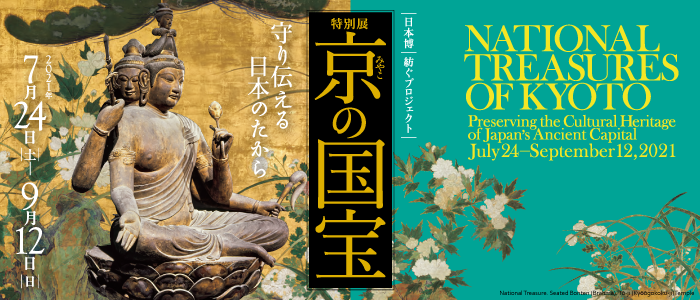
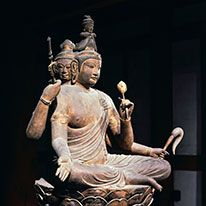
![Research Survey Fieldwork Notebooks (No. 5, Byōdō-in). By Niiro Chūnosuke. Bijyutsuin, Kyoto [pages on display change]](../../../jp/special/img/20210724/kokuho2021_1-1-0_3F-1_tmb.png)
![National Treasure. Landscape with Figures. Kyoto National Museum [on view: July 24–August 22, 2021]](../../../jp/special/img/20210724/kokuho2021_1-2-1_3F-2_tmb.jpg)
![National Treasure. Diary of Fujiwara no Michinaga (Midō Kanpaku ki), Vol. 1 from the Year 1011 (Kankō 8). By Fujiwara no Michinaga. Yōmei Bunko Foundation, Kyoto [this scroll on view: August 24–September 12, 2021]](../../../jp/special/img/20210724/kokuho2021_1-2-2_3F-2_tmb.jpg)
![National Treasure. Birds and Flowers. By Kano Eitoku. Jukō-in Temple, Kyoto [on view: August 24–September 12, 2021]](../../../jp/special/img/20210724/kokuho2021_2-1-2_2F-3_tmb2.jpg)
![National Treasure. Pine Tree and Autumn Plants. By Hasegawa Tōhaku. Chishaku-in Temple, Kyoto [on view: July 24–August 22, 2021]](../../../jp/special/img/20210724/kokuho2021_2-1-1_2F-3_tmb.jpg)
![National Treasure. Tales of Times Now Past (Konjaku monogatari shū), Suzuka Edition, Vol. 29. Kyoto University Library [this book on view: July 24–August 22, 2021]](../../../jp/special/img/20210724/kokuho2021_2-2-1_2F-4_tmb.png)

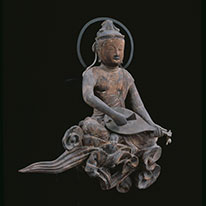
![National Treasure. Box for Wish-Fulfilling Jewel with Auspicious Floral Design. Ninna-ji Temple, Kyoto [on view: July 24–August 22, 2021]](../../../jp/special/img/20210724/kokuho2021_2-5-1_1F-2_tmb.jpg)
![Selected Poems by Bai Juyi, Known as Album of the Jeweled Spring (Gyokusenjō). Calligraphy by Ono no Michikaze. The Museum of the Imperial Collections, Sannomaru Shōzōkan [on view: August 24–September 12, 2021]](../../../jp/special/img/20210724/kokuho2021_3-0-2_1F-3_tmb.jpg)
![National Treasure. Illustrated Chronicles of the Miracles of the Kasuga Deity (Kasuga Gongen genki e), Vol. 2.
Painting by Takashina Takakane. Calligraphy by Takatsukasa Mototada and his descendants. The Museum of the Imperial Collections, Sannomaru Shōzōkan [this scroll on view: July 24–August 22, 2021]](../../../jp/special/img/20210724/kokuho2021_3-0-1_1F-3_tmb.jpg)
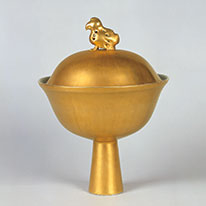
![National Treasure. Merrymaking under the Blossoms. By Kano Naganobu. Tokyo National Museum [on view: September 7–12, 2021]](../../../jp/special/img/20210724/kokuho2021_4-2-2_1F-5_tmb.jpg)
![Phoenix. Rokuon-ji Temple, Kyoto [on view: July 24–September 5, 2021]](../../../jp/special/img/20210724/kokuho2021_4-2-1_1F-5_tmb.jpg)
